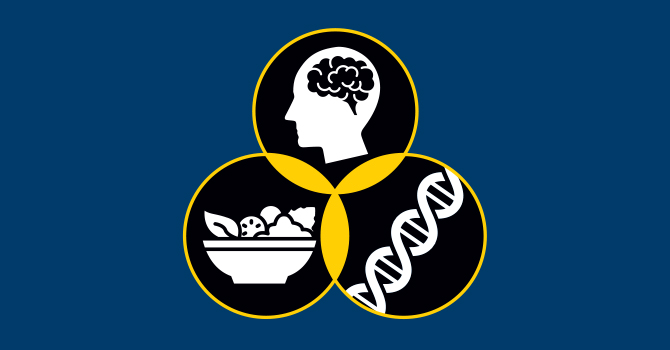Instructions for Life: How Food, Stress, and Our Genes Shape Our Health

Experts from the University of Michigan School of Public Health unpack how our genes respond to changes in our diets, stress levels, and exposure to toxins—and what these interactions mean for human health.
Listen to "Instructions for Life: How Food, Stress, and Our Genes Shape Our Health" on Spreaker.
|
Subscribe and listen to Population Healthy on Apple Podcasts, Spotify, Google Podcasts, iHeartRadio, YouTube or wherever you listen to podcasts! Be sure to follow us at @umichsph on Twitter, Instagram, and Facebook, so you can share your perspectives on the issues we discussed, learn more from Michigan Public Health experts, and share episodes of the podcast with your friends on social media. |
[music]
00:03 Kelly Bakulski: You could think of the genome as this enormous piano with all of the keys as genes. The epigenome, then, is your sheet music that you use to play a specific, beautiful song on that piano—the when and how each key can be struck to change this sound. There's tons of songs you can play on that one piano.
00:25 Speaker 2: This episode of Population Healthy is called Instructions for Life, How Food Stress and Our Genes Shape Our Health. What we're really talking about is epigenetics. But before we get fully into that, let's take a crash course on genetics. To put it simply, DNA is a unique chemical code inside every cell of every living thing. A gene is a specific section of this DNA. Genes are passed from parents to offspring, and they determine much of who we are, how we grow and whether we get sick. A genome then is the entire complicated collection of genes and DNA code of an organism. Human beings have nearly 20,000 genes. In 1990 researchers around the world began working on the Human Genome Project, a 13-year-long publicly funded effort to map all of the human genome. The project involved hundreds of labs and thousands of researchers, openly sharing their findings. In April 2003, the Human Genome Project was declared complete. This knowledge of human genetics has ushered in new forms of medicine and helped us identify and begin to understand our genes and the roles they play.
01:33 S2: Hello and welcome to Population Healthy, a podcast from the University of Michigan School of Public Health. Join us as we dig into important public health topics, stuff that affects the health of all of us at a population level, from the microscopic to the macroeconomic, the social to the environmental, from neighborhoods to cities, states to countries and around the world.
[music]
02:06 S2: There's a collection of chemicals and processes that surround our genes and determine when and how they'll actually be expressed, known as the epigenome. The field of epigenetics looks at how the world around us, from stress, to food, to toxicants affects how our genes do or don't help us develop in healthy ways. We asked Dana Dolinoy, the NSF International Chair and Professor of Environmental Health Sciences and Nutritional Sciences, and Kelly Bakulski, Assistant Professor of Epidemiology both at the University of Michigan School of Public Health to explain the epigenome. The first voice you'll hear is Dana.
02:42 Dana Dolinoy: The epigenome is a big word, but it literally means in addition to or above the genome. It's the instruction book that tells all our genes when to turn on, where to turn on, how much to turn on. A useful analogy for the epigenome is a computer. Your computer has a hard drive and that hard drive has a lot of data, but that data just is there until the software, or in this case, the epigenome, comes along and tells it what to do. In fact, every cell in our body has the same complement of DNA, but we don't want every gene expressed from every cell in our body, so we use epigenomic software to help tell genes when to turn on and where to turn on.
03:21 Kelly Bakulski: I've been really curious about the epigenome for years, ever since I was sitting in a biology class in high school, thinking about how does a single genome give rise to the diversity of cell types in our body? So from early on when we start out as a rapidly dividing ball of cells, our cells start to specialize and take on specific roles. This is a process called cellular differentiation. Cellular differentiation and development rely on epigenetic mechanisms, all of the cells in that ball have the same DNA sequence, but as they acquire epigenetic differences the cells can take on different expertise and shapes. We have neuron cells in our body that are three feet long and that signal with electrical charges. We have gastric cells in our stomachs that can secrete acid and survive surrounded in an acid environment that would kill other cells in your body. We have osteoblast cells that make the dense organic matrix that is our bones. We have T cells that can tell what cells belong in your body and what cells are invaders to go and attack those invading cells. All of this beautiful cellular diversity and our body is because the cells are using that same identical DNA sequence differently via their epigenomes.
04:29 S2: To help think about the epigenome's role, consider the case of identical twins.
04:34 KB: Two identical twins at birth will have the same DNA sequence and very similar epigenomes and when those two identical twins are 90 years old, they will still have the same DNA sequence, but they will have very different epigenomes. Those twins will have accumulated a lifetime of different environments and different experiences that will be reflected in their epigenomes.
04:52 DD: One of the things that we think about in public health is how our environment can impact our epigenome. And the word environment in this context is really broad. So this can be the toxicants that we are exposed to through things like air pollution or consumer products, but it can also be things we eat, so what's in our water, what's in our diet? It can also be experiences in behavior, things like stressful experiences or even positive experiences such as meditation may be able to affect your epigenome. The way that environmental factors change the epigenome is through a series of switches and markers, these epigenetic mechanisms. And one of the most extensively studied switches is called DNA methylation, which is a mouthful. It's actually simply a carbon and three hydrogens. And this molecule sits down on DNA and acts like a dimmer switch, like a light switch. A gene that lacks DNA methylation can be brightly expressed, but that same gene can gain DNA methylation and be more dimly expressed.
05:59 DD: This dimmer, this epigenetic mechanism allows us to have control over how much of our gene is expressed. We have many genes in our body that are just so critical to daily minute by minute functions. These are called housekeeping genes. We want these genes on all the time and want them working and so that would mean that we do not want these genes methylated, we want them on and pumping and going.
06:22 KB: A healthy diet is essential to maintaining a healthy epigenome. Factors in our diets such as folic acid, provide the building blocks to produce DNA modifications that are essential for a healthy epigenome. We have guidelines to help support and make sure that pregnant women have adequate supplies of folic acid in their diet or through supplementation in order to be able to support a developing epigenome. Babies born to mothers who smoke cigarettes regularly during pregnancy have measurable epigenetic differences compared to babies born to mothers who did not smoke cigarettes regularly during pregnancy. There is a specific signature on the baby's epigenome at birth that represents the environment the fetus experienced during pregnancy.
07:01 DD: One of the things that we should think about when our environment affects our epigenome is the fact that we as researchers focus on negative impacts, but there is the possibility for an environmental influence on our epigenome to be neutral, it doesn't really affect anything at all, or it could be positive or adaptive.
07:19 KB: I see the field of epigenetics as a very hopeful field of research, and it's inspired my science to be very hopeful. Our DNA sequence is critically important for our health and the field of epigenetics shows that how our bodies use that DNA sequence is also key. There's potential for change and there's potential for intervention.
[music]
07:43 S2: As a doctoral student at Duke University Dolinoy was introduced to epigenetics through Dr Randy Jirtle. In a groundbreaking experiment, the same mouse mother gave birth to two very different looking litters.
07:55 DD: One mouse was brown and slender and the other mouse was yellow and obese. And what was different between these two mice was the diet that the mother was fed during pregnancy. And this is where I was first introduced to the epigenome through Dr Randy Jirtle in his famous study with these viable yellow agouti mice. What we did with the mice, instead of thinking about the mother's diet, we instead thought about what happens when the mom is exposed to toxic chemicals. And in particular, we were interested in these endocrine-disrupting chemicals, like Bisphenol A or BPA, for short. And what happened is when we fed the mouse mothers BPA in their diet, they were more likely to have the yellow obese mice. Unlike the genome which is static and not modifiable, the epigenome is dynamic and potentially modifiable. It's somewhat hopeful. And so we did a second study, instead of just giving the mother Bisphenol A, we gave her Bisphenol A, but also a diet that was really good, it was high in things like methionine, betaine, vitamin B12. These are things that are found in green leafy vegetables, they're called methyl donors.
09:10 DD: And when we did this, we saw that the moms were more likely to have the brown slender pups that have the DNA methylation. And so this showed that at least in a developmental context, exposures to toxic chemicals could be negated by a very good diet through an epigenetic mechanism. And this was really cool, this allowed for a hope that we might be able to do something about the environmental exposures that we cannot control on our own.
[music]
09:45 S2: So what does this mean for us? Karen Peterson, Chair and professor of Nutritional Sciences at the University of Michigan School of Public Health uses epigenetics to study how children grow and the environmental exposures that can affect their development.
09:59 Karen Peterson: So there's several pieces of the puzzle to understand physical growth and development and maturation during a child's life, from the time really they're developing in the womb through puberty. Many of those processes are regulated by hormones and we are doing research that looks at whether some of these chemicals that are disrupting potentially the endocrine system might actually be affecting growth and development through their ability to affect epigenetic changes or expression of certain genes that are exquisitely linked to how children grow and grow up. That's really why we care about epigenetics in this context. Over the years in my career I've been fortunate to design different nutrition programs that promoted healthy diet, healthy activity, and those were somewhat successful in managing children's weight status, ensuring that they didn't develop risk for cardiometabolic diseases, diabetes, things like that later in life.
11:00 KP: And at some point I realized I was seeing what I thought were stronger effects of these nutrition programs in different ages. So for example, when we think about obesity and what periods of life might be periods where obesity could emerge early, but then leave this child with really a trajectory where they may end up overweight or obese later in life and/or have related chronic conditions, you could start to see that it's the transitions from the womb, early life during pregnancy to the outside world as an infant. And then when a child is moving from preschool to school years is another what we might see as a vulnerable or sensitive period in child development where risk for obesity increases. And then similarly, adolescence in the transition to young adulthood. So where does epigenetics fit in that picture? I designed interventions, they were somewhat successful in improving nutrition and improving physical activity and slightly reducing the risk of overweight and obesity in childhood.
12:04 KP: But what I wanted to do was be able to look behind the scenes and for example, understand, well, in this study, why was there a bigger effect in girls of a nutrition program? Oh, was it because they were at a certain age? So, what's behind the scenes driving those changes? And epigenetics is one of three or four new technologies, fields really, if you will, that have allowed us to look behind the scenes and understand some of the more direct biological mechanisms that might be attuned to changes in nutrition or even attuned to changes in toxicants. And those are part of the picture of what's driving children's increased risk or decreased risk of poor growth outcomes during certain periods. So for me epigenetics is very fascinating because I can finally look behind the scenes and try to understand why is it exactly that nutrition and/or reduction of toxicant exposures and/or physical activity might reset a child's growth trajectory in a way that's more powerful than it might be if we did it at older ages?
13:14 S2: To investigate this Peterson and a team of collaborators started a research study in Mexico City 25 years ago called The ELEMENT Study. The field of epigenetics has become increasingly important.
13:26 KP: So, the ELEMENT Study started in the mid-'90s and we were looking at chemicals and their effects on cognition and the potential for nutrients to counteract those effects. By a decade later, when we were still recruiting women into the study, epigenetics really was available as a tool to understand how toxicants, and again, nutrient exposures might actually affect a range of health outcomes that we study, such as growth and development, how fast children mature, their cognitive development in later life and even their risk of disease. I was fortunate to be a part of the group of the original collaborators that started that study and what we cared about when we started the study was how could we reduce the effects of lead exposure in pregnant women by providing them with calcium supplementation? We were interested, actually, in blocking some of the effects lead has on children's cognitive development and also ultimately on their school performance.
14:30 KP: Over the years, as these women who originally participated in the study have had more children and those children have grown up, many of them are now adolescents or young adults, we've been able to look at a broader range of chemicals, lead, cadmium, endocrine-disrupting chemicals that we might find in the food supply or in personal care products, and understand how those chemicals, as well as good nutrition and even physical activity might work together to affect other health outcomes in children.
[music]
15:10 S2: There's still a lot of work to do to fully harness epigenetics to address human health and prevent disease, researchers will continue to develop the interventions that at the moment are showing great promise.
15:20 DD: When I think about the future of environmental epigenetics, I think about two major challenges. The first is now we need to sequence, this time, the epigenome all over again, and it's a much bigger task because the epigenome varies by cell. We have some 200 different cell types. The epigenome varies by time, so we have to measure many different time points. And the genome is affected by the environment and so we need to encounter many different environmental exposures. So this is a very big task to do, although there are many initiatives underway to do this. Then the second biggest challenge is I've mentioned that the epigenome is hopeful but right now, our tools are like blunt instruments, they will whack your epigenome over the head and they will change every single bit of it. Now, this may be good if you have certain end stage cancer, and in fact, we have several FDA-approved drugs, that are global epigenetic modifiers. They're very effective at extending life but they also have a lot of side effects. So we need to develop new tools that are targeted streamline tools that can do epigenome editing. Though we’re probably several decades away from doing these things, these are the types of things we have to start working on now if we want to be able to completely harness the power of the epigenome in the future.
[music]
16:49 S2: Thanks for listening to this episode of Population Healthy from the University of Michigan School of Public Health. We're glad you decided to join us and we hope you learned something that will help improve your own health or make the world a healthier place. If you enjoyed the show, please subscribe or follow this podcast on iTunes, Apple Podcasts, Google Play, Stitcher, Spotify, or wherever you listen to podcasts. Be sure to follow us at umichsph on Twitter, Instagram, and Facebook, so you can share your perspectives on the issues we discuss, learn more from the Michigan Public Health experts and share episodes of the podcast with your friends on social media. You can also check out the show notes on our website, publichealth.umich.edu/podcast, for more resources about the topics discussed in today's episode. If you want to stay up-to-date with the latest research and expertise from Michigan Public Health subscribe to our Population Healthy newsletter at publichealth.umich.edu/news/newsletter. We hope you join us for next week's episode where we'll dig further into public health topics that affect all of us at a population level.
In This Episode
 Dana Dolinoy
Dana Dolinoy
NSF International Chair and Professor of Environmental Health Sciences and Professor of Nutritional Sciences at the University of Michigan School of Public Health
Dana Dolinoy leads the Environmental Epigenetics and Nutrition Laboratory, which investigates how nutritional and environmental factors interact with epigenetic gene regulation to shape health and disease. In 2012, she was the recipient of the Association of Schools of Public Health (ASPH)/Pfizer Research Award for the article "An Expression Microarray Approach for the Identification of Metastable Epialleles in the Mouse Genome." This work was cited as a model approach that may allow for directly assessing the role of early environmental exposures in human adult disease. Learn more.
 Kelly Bakulski
Kelly Bakulski
Assistant Professor of Epidemiology at the University of Michigan School of Public Health
Kelly Bakulski’s current research integrates and applies multiple genome-wide measures to understand disease risk. She investigates the in utero effects of environmental exposures, such as metals and one-carbon metabolites, on the newborn epigenome, transcriptome, and ultimately risk of autism spectrum disorders. In addition, she studies the interactions between multiple pollutant exposures and genetics in aging populations on the risk of cognitive decline. Learn more.
 Karen Peterson
Karen Peterson
Professor and Chair of the Nutritional Sciences Department at the University of Michigan School of Public Health
Karen Peterson’s research focuses on the influence of biosocial and environmental influences on child growth and maturation during sensitive developmental periods, as well as the design and evaluation of population-based interventions addressing dietary and physical activity behaviors related to obesity and chronic disease in diverse populations, including children and youth. Learn more.
